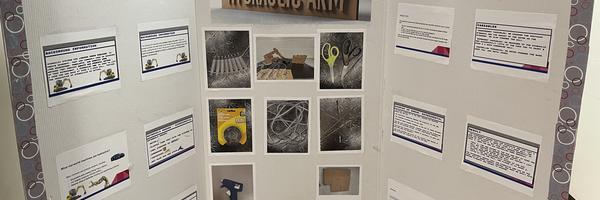The Hydraulic Arm
Grade 6
Presentation
No video provided
Hypothesis
The hydraulic arm will successfully lift the Coke can over the 4-inch cardboard wall and place it at Point B if the arm has sufficient strength, range of motion, and height.
Research
Hydraulic systems use liquids under pressure to create movement. They are commonly used in machines like excavators, forklifts, and robotic arms because they provide smooth and powerful motion. In this experiment, a hydraulic arm is used to lift a Coke can and move it over a 4-inch wall, testing the principles of hydraulics in action. The hydraulic arm operates using syringes, tubes, and water. When one syringe is pushed, the water inside moves through the tube and pushes another syringe, causing the arm to move. This process is based on Pascal’s Law, which states that pressure applied to a fluid in a closed system is transmitted equally in all directions.
Variables
-
Independent variables: We changed the gripping strength and the amount of the water in the syringes. We also changed the wall.
Dependent variables: We measured if the hydraulic arm successfully lifts up the coke can to point b over a 4 inch cardboard wall.
Controlled variables: We never changed the base, Coke can, and Metal wires.
Procedure
Step 1: Get materials
Step 2: Making the blueprint
Step 3: Make arm support and forearm
Step 4: Make the gripper/hand/claw
Step 5: Drilling the holes
Step 6: Dry fitting
Step 7: Cutting the metal wires
Step 8: Preparing the syringes
Step 9: Placing the syringes
Step 10: Rotating platform mechanism
Step 11: Finish the gripper
Step 12: Snip the ends of the toothpick
Step 13: Inserting the water
Step 14: insert the plastic tubes
Step 15: Check for leaks
Step 16: It’s Complete
Observations
- The arm successfully grabbed the can in all trials, showing the gripper worked well.
- In Trial 1, the arm lifted the can over the wall but dropped it.
- In Trial 2, the arm couldn’t lift the can high enough.
- In Trial 3, the arm lifted the can, moved it over the wall, and placed it at the target.
Analysis
Conclusion
The experiment showed that the hydraulic arm can lift a Coke can from Point A, move it over a 4-inch wall, and place it at Point B. But this only worked perfectly in Trial 3, when the arm was controlled more smoothly.
- Trial 1: The arm picked up the can and got it over the wall but dropped it before reaching Point B.
- Trial 2: The arm picked up the can but couldn’t lift it high enough to go over the wall.
- Trial 3: The arm successfully picked up the can, lifted it over the wall, and placed it at Point B.
The experiment proves that the hydraulic arm can do the task, but it needs careful control and must be built with enough strength and height to succeed.
Application
Sources Of Error
-The water leaking out of the tube reduced the pressure needed for the arm
-The Toothpicks breaking reduced the stability of the arm
-The Syringes slipping out of zip ties
-Excessive force caused syringes to pop out of their holders
-The hot glue joints snapped, causing parts of the structure, such as the rotating system, to stop functioning properly.
-the claw not closing fully making it difficult to grip and hold the Coke can securely.
-The glue blocking the entry of the plastic tube making it hard to push the syringe to make the arm work.

